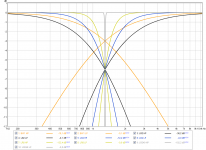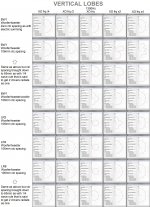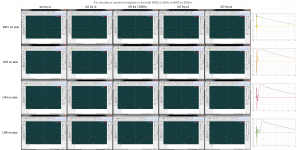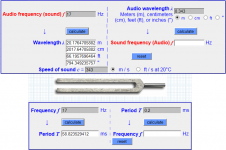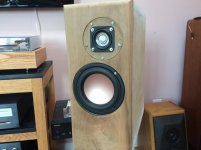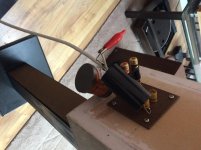Add to vertical radiation
XO vertical radiated power response from post 78 continued.
Added LR2/LR4/LR8 and two examples setting spacing <1/4 wave rule.
To create data made slopes in Rephase as IR-wav file then imported into REW where dB setting for XDir was decoded.
Picture 1 show slopes into REW plus a exstra brickwall LR249 because could imagine will have a very narrow lobe that will degrade power response but think will need FIR filter else phase distortion will be too manipulating to input wave. FIR filters would be good for all the LR ones in they would get flat phase and then perform square waves at least on axis.
Picture 2 could be upgraded with HARSH on request, but it will take some time and concentration to get right because phase is probably only real coherent exactly at XO point where LR is easy in they always in phase and BW1 always 90º apart in textbook scenario.
Picture 3 is square waves and IR/SR related to picture 2 plots and created with live soundcard loop 16bit/48kHz, therefor bandwidth is limited to below 24kHz so expect that will add a bit ringing to last octave.
Hope is usefull information personal learned a lot having visuals to help understand radiation and power response in XO region when sources is physical spaced apart.
XO vertical radiated power response from post 78 continued.
Added LR2/LR4/LR8 and two examples setting spacing <1/4 wave rule.
To create data made slopes in Rephase as IR-wav file then imported into REW where dB setting for XDir was decoded.
Picture 1 show slopes into REW plus a exstra brickwall LR249 because could imagine will have a very narrow lobe that will degrade power response but think will need FIR filter else phase distortion will be too manipulating to input wave. FIR filters would be good for all the LR ones in they would get flat phase and then perform square waves at least on axis.
Picture 2 could be upgraded with HARSH on request, but it will take some time and concentration to get right because phase is probably only real coherent exactly at XO point where LR is easy in they always in phase and BW1 always 90º apart in textbook scenario.
Picture 3 is square waves and IR/SR related to picture 2 plots and created with live soundcard loop 16bit/48kHz, therefor bandwidth is limited to below 24kHz so expect that will add a bit ringing to last octave.
Hope is usefull information personal learned a lot having visuals to help understand radiation and power response in XO region when sources is physical spaced apart.
Attachments
About the effect of the Scotchbrite pads on diffraction in Post # 1. I can't see any real difference between the red and blue curves other than slight experimental variations. Am I missing something?
The red and blue curves are repeatable and not experimental variations. It may not seem like much but the reduction in wiggles and less dips and peaks from 500Hz to 4kHz are sonically audible as a smoother sound. It also helps polars smooth out.
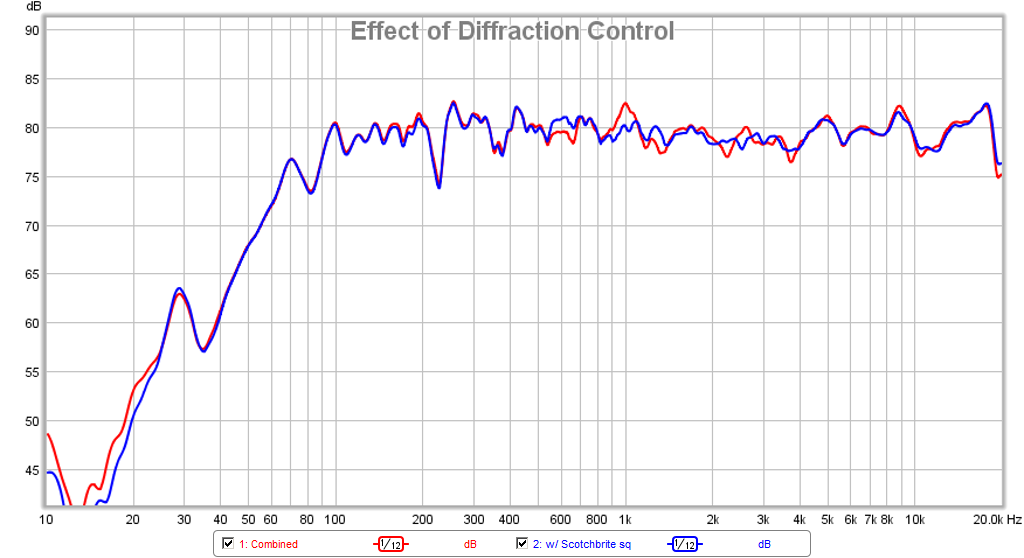
Last edited:
No offence,but I think you're reading too much into what are very minor differences between the two curves and are hearing what you expect to hear on audition. I would also point out that the curves indicate more significant differences in the very low bass region which the Scotchbrite pads couldn't possibly be responsible for, reinforcing my suggestion that what you're seeing are just measurement variations.
Your audio memory is nowhere near accurate enough to remember what the speakers sounded like before and after treatment and, in any case, differences in head positioning between the two listening tests would probably far outweigh any sonic changes caused by the minor effects seen in the curves.
What you've presented isn't convincing proof of controlling diffraction IMHO.
Your audio memory is nowhere near accurate enough to remember what the speakers sounded like before and after treatment and, in any case, differences in head positioning between the two listening tests would probably far outweigh any sonic changes caused by the minor effects seen in the curves.
What you've presented isn't convincing proof of controlling diffraction IMHO.
Last edited:
Now you are being silly. HVAC rumble in building has content below 30Hz.
Frankly I'm tired of your questions as you have managed to miss the whole point about the speaker being transient perfect. The scotchbrite was something I thought Inwould try given the millions of happy LS3/5A owners and I happened to measure the before and after.
Frankly I'm tired of your questions as you have managed to miss the whole point about the speaker being transient perfect. The scotchbrite was something I thought Inwould try given the millions of happy LS3/5A owners and I happened to measure the before and after.
Last edited:
and what of the 8 dB difference at 17 Hz. How do you explain that?
Own experience is below 30Hz area trace from repeated measurement is impossible to replicate, and looking at a live RTA measuring in real world enviroment shows there is plenty of LF rumble going on down there.
Also wavelengths is more than 20 meters at 17Hz think will probably need more than a handful scotchbrite to damp 8dB.
Attachments
Last edited:
No offence,but I think you're reading too much into what are very minor differences between the two curves and are hearing what you expect to hear on audition.....
Right amplitude change is not much but look how Q for amplitude change is lowered so after add with scotchbrite it looks more as a soft broad amplitude change than before where sharp dips and peaks looks like a resonator.
I am thinking of reviving an old design here but with a passive XO this time. I still have not found another suitable project for the AC130's and thought it a waste to not use them. I have a nice Class AB with 60w of power now that could use some dedicated bookshelf speakers.
This was the XO plot with miniDSP. Now to recreate this with passive 1st order...
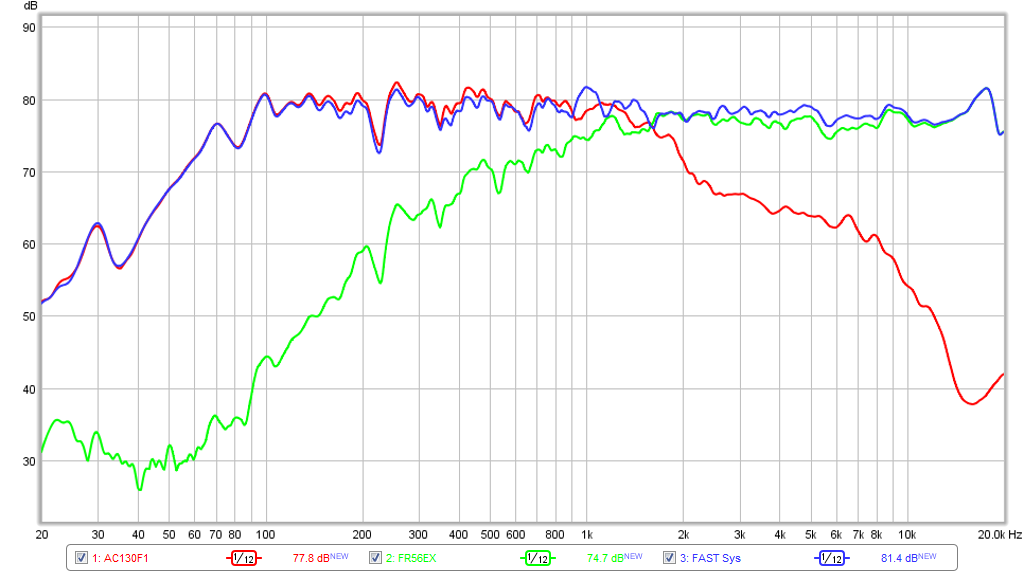
Here was the Step Response:
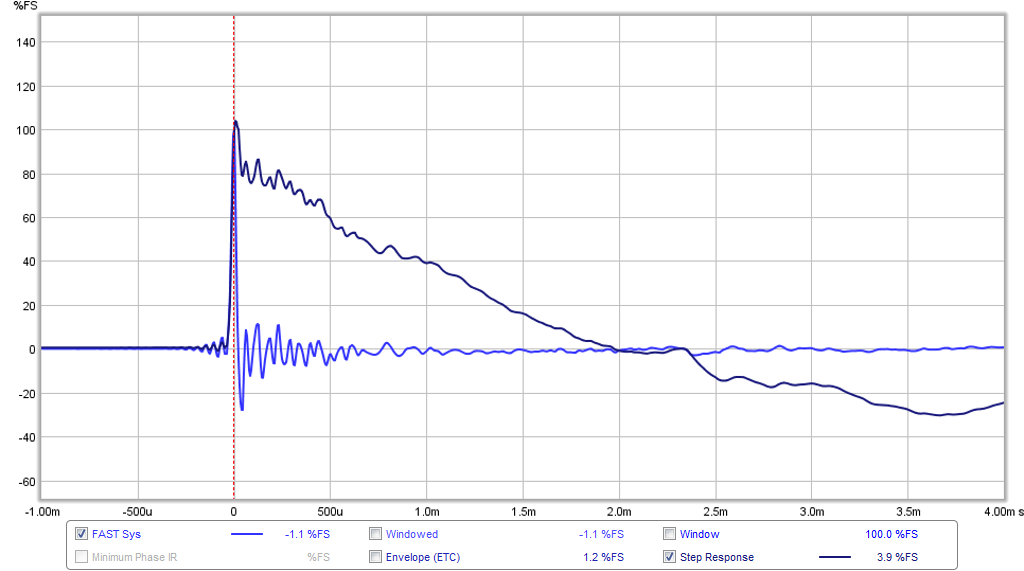
This was a decent sounding FAST!
This was the XO plot with miniDSP. Now to recreate this with passive 1st order...

Here was the Step Response:

This was a decent sounding FAST!
Hi XRK:
I too am very interested in this as I'm evaluating FR58EX for a line array but I could also use a pair of these FASTs on my desk and I already have a pair of the very nice 5FE120s to use with the FR58s.
In all my multiple measurements of the FR58EX I find a 5 db peak at 9200 Hz or so for which I can't find a cause other than the driver itself. The impulse response shows an early reflection, so early that it likely comes from the driver frame itself. There is no sign of that peak on the data sheet frequency response or in the measurement you posted in your best small driver poll thread. I do see that peak, albeit only 3 db high, in your measurement of this design early in this thread and I wonder if you have contended with it and/or come to any conclusion about it. Is it a fatal flaw for the driver or should I equalize it away and move on because in other respects it seems a very nice driver?
I too am very interested in this as I'm evaluating FR58EX for a line array but I could also use a pair of these FASTs on my desk and I already have a pair of the very nice 5FE120s to use with the FR58s.
In all my multiple measurements of the FR58EX I find a 5 db peak at 9200 Hz or so for which I can't find a cause other than the driver itself. The impulse response shows an early reflection, so early that it likely comes from the driver frame itself. There is no sign of that peak on the data sheet frequency response or in the measurement you posted in your best small driver poll thread. I do see that peak, albeit only 3 db high, in your measurement of this design early in this thread and I wonder if you have contended with it and/or come to any conclusion about it. Is it a fatal flaw for the driver or should I equalize it away and move on because in other respects it seems a very nice driver?
Zman01:
No progress on a passive XO here. Too busy with amp projects lately.
nc535:
I don’t recall the 9kHz peak being an issue - so I may have EQ’d it out for this speaker as it was miniDSP based. It’s not a big deal to don-ve EQ of a small bump. Don’t EQ to raise dips.
But in general, it’s an excellent driver and fully usable for any FAST application.
No progress on a passive XO here. Too busy with amp projects lately.
nc535:
I don’t recall the 9kHz peak being an issue - so I may have EQ’d it out for this speaker as it was miniDSP based. It’s not a big deal to don-ve EQ of a small bump. Don’t EQ to raise dips.
But in general, it’s an excellent driver and fully usable for any FAST application.
First effort
I repurposed an enclosure originally intended to be a ZD5 and fitted the Fountek and HiVi m5n. Light stuffing in the sealed cabinet and a 1.8mh inductor on the woofer and 30uf cap on the Fountek. With a little eq using my HK Citation 17, it sounds promising without any padding on the tweeter. Now to assemble the second one.
I repurposed an enclosure originally intended to be a ZD5 and fitted the Fountek and HiVi m5n. Light stuffing in the sealed cabinet and a 1.8mh inductor on the woofer and 30uf cap on the Fountek. With a little eq using my HK Citation 17, it sounds promising without any padding on the tweeter. Now to assemble the second one.
Attachments
Not yet. I’m hunting for some misplaced 4” dia heavy cardboard tubes that I bought from PE a while ago. I’ll cut about 2” long and glue them in place around the Fountek, lightly stuffed....when I find them.
I’m surprised how clean the speaker sounds without the full range driver being enclosed.
I’m surprised how clean the speaker sounds without the full range driver being enclosed.
- Status
- This old topic is closed. If you want to reopen this topic, contact a moderator using the "Report Post" button.
- Home
- Loudspeakers
- Full Range
- FR58EX and AC130F1 micro-FAST / WAW
